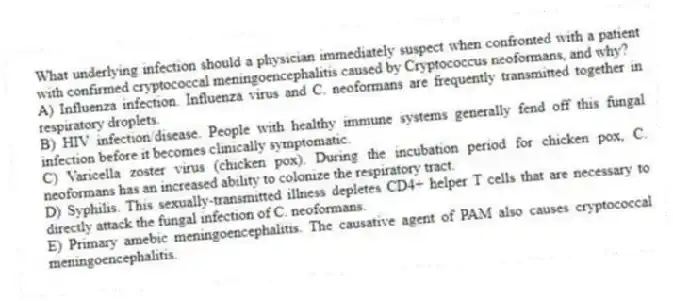
What underlying infection should a physician immediately suspect when confronted with a patient with confirmed cryptococcal meningoencephalitis caused by Cryptococcus neoformans, and why?
A) Influenza infection. Influenza virus and C. neoformans are frequently transmitted together in respiratory droplets.
B) HIV infection/disease. People with healthy immune systems generally fend off this fungal infection before it becomes clinically symptomatic.
C) Varicella zoster virus (chicken pox) . During the incubation period for chicken pox, C. neoformans has an increased ability to colonize the respiratory tract.
D) Syphilis. This sexually-transmitted illness depletes CD4+ helper T cells that are necessary to directly attack the fungal infection of C. neoformans.
E) Primary amebic meningoencephalitis. The causative agent of PAM also causes cryptococcal meningoencephalitis.
Correct Answer:
Verified
Q36: The poliomyelitis virus appears to selectively destroy
A)
Q37: Intestinal botulism, especially in infants, has been
Q38: The incubation period of rabies is partially
Q39: The symptom at the site of an
Q40: The polio viruses usually enter the body
Q42: The more severe form of African sleeping
Q43: Mycobacterium leprae is only grown in living
Q44: Viral meningitis is much more common than
Q45: Central nervous system (CNS) diseases caused by
Q46: Corneal implants have been implicated in a
Unlock this Answer For Free Now!
View this answer and more for free by performing one of the following actions

Scan the QR code to install the App and get 2 free unlocks

Unlock quizzes for free by uploading documents